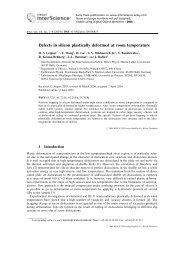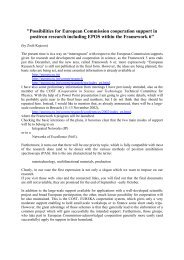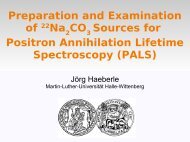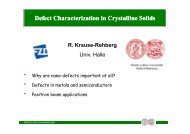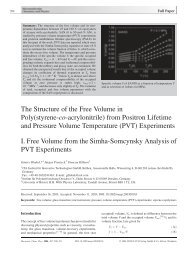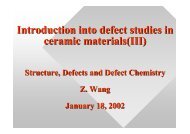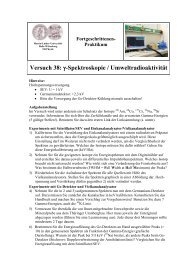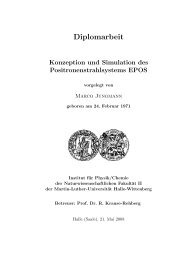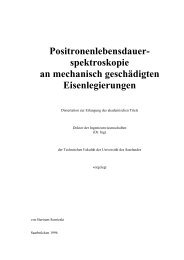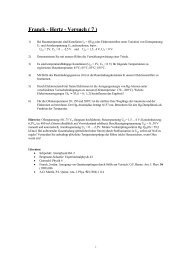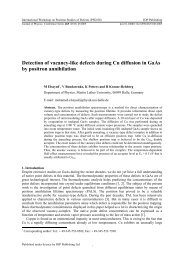Download PDF-File - Positron Annihilation in Halle
Download PDF-File - Positron Annihilation in Halle
Download PDF-File - Positron Annihilation in Halle
Create successful ePaper yourself
Turn your PDF publications into a flip-book with our unique Google optimized e-Paper software.
G. Dlubek et al.: o-Ps Lifetime Distribution <strong>in</strong> Polymers (II) 303<br />
phys. stat. sol. (a) 172, 303 (1999)<br />
Subject classification: 61.41.+e; 71.60.+z; 78.70.Bj; S12<br />
Do MELT or CONTIN Programs Accurately Reveal<br />
the o-Ps Lifetime Distribution <strong>in</strong> Polymers?<br />
II. Semicrystall<strong>in</strong>e Polymers 1 †<br />
G. Dlubek (a), Ch. HuÈbner (b), and S. Eichler (b)<br />
(a) ITA Institut fuÈ r <strong>in</strong>novative Technologien GmbH, KoÈthen, Auûenstelle <strong>Halle</strong>,<br />
Edvard-Grieg- Weg 8, D-06124 <strong>Halle</strong>/Saale, Germany<br />
e-mail: gdlubek@aol.com<br />
(b) Fachbereich Physik, Mart<strong>in</strong>-Luther-UniversitaÈt <strong>Halle</strong>-Wittenberg,<br />
D-06099 <strong>Halle</strong>/Saale, Germany<br />
(Received November 12, 1998; <strong>in</strong> revised form February 2, 1999)<br />
<strong>Positron</strong> lifetime experiments of high statistical accuracy (50 M total co<strong>in</strong>cidence count) were performed<br />
for various polyethylene samples with different degrees of crystall<strong>in</strong>ity of X c = 43, 60, and<br />
70%. Four lifetime components were resolved us<strong>in</strong>g the MELT, CONTIN, or the discrete-term<br />
LIFSPECFIT rout<strong>in</strong>es. Two long-lived components appear, their lifetimes (t 3 = 1.1 to 1.2 ns and<br />
t4 = 2.6 to 2.7 ns) and <strong>in</strong>tensities (I3 = 5 to 8% and I4 = 13 to 24%) vary systematically with Xc.<br />
t4 arises from o-Ps annihilation <strong>in</strong> holes of the amorphous phase while t3 may be attributed to<br />
crystals. From a detailed analysis of computer-generated spectra it was concluded that artefacts<br />
may appear <strong>in</strong> the analysed lifetime parameters t i and Ii when the fourth lifetime is assumed to<br />
have a (Gaussian) distribution (due to a hole size and shape distribution). The artefacts are due to<br />
the <strong>in</strong>ability of the rout<strong>in</strong>es correctly to mirror very broad lifetime distributions. The most significant<br />
effect is an <strong>in</strong>crease <strong>in</strong> the analysed parameters t 3, t4 and I3 but a decrease <strong>in</strong> I4, compared<br />
with the simulation <strong>in</strong>put, with <strong>in</strong>creas<strong>in</strong>g width of the simulated distribution of the fourth lifetime.<br />
From this it follows that care must be taken when discuss<strong>in</strong>g values of and changes <strong>in</strong> the lifetime<br />
parameters of semicrystall<strong>in</strong>e or other two-phase polymers. A comparison of the parameters analysed<br />
from experimental spectra with those from simulated ones appears always advisable.<br />
<strong>Positron</strong>enlebensdauerexperimente mit hoher statistischer Genauigkeit (Gesamtzahl von Ko<strong>in</strong>zidenzereignissen<br />
50 Millionen) wurden fuÈ r verschiedene Polyethylenproben mit unterschiedlichem<br />
Kristall<strong>in</strong>itaÈtsgrad von X c = 43, 60 und 70% durchgefuÈ hrt. Unter Nutzung der Programme MELT,<br />
CONTIN oder LIFSPECFIT (diskrete Zerfallsterme) wurden vier Lebensdauerkomponenten aufgeloÈ<br />
st. Es treten zwei langlebige Komponenten auf, deren Lebenszeiten (t 3 = 1,1 ±1,2 ns und t4 =<br />
2,6 ±2,7 ns) und IntensitaÈten (I3 =5±8% und I4 =13±24%) systematisch mit Xc variieren. Aus<br />
e<strong>in</strong>er detaillierten Analyse von computergenerierten Spektren wurde geschluûfolgert, daû Artefakte<br />
<strong>in</strong> den analysierten Lebensdauerparametern ti und Ii auftreten koÈ nnen, wenn vorausgesetzt<br />
wird, daû die vierte Lebenszeit e<strong>in</strong>e (Gauss-foÈ rmige) Verteilung aufweist (die auf e<strong>in</strong>e HohlraumgroÈ<br />
ûen- und Formverteilung zuruÈ ckzufuÈ hren ist). Die Artefakte treten aufgrund der mangelnden<br />
Eignung der Auswerteprogramme auf, sehr breite Lebensdauerverteilungen genau zu widerzuspiegeln.<br />
Der bedeutendste Effekt ist e<strong>in</strong> Anstieg <strong>in</strong> den analysierten Parametern t 3, t4 und I3 und e<strong>in</strong><br />
Abfall <strong>in</strong> I4, verglichen mit den Ausgangsparametern der Simulation, mit wachsender Breite der<br />
simulierten Verteilung der vierten Lebenszeit. Daraus folgt, daû bei der Diskussion von GroÈ ûen<br />
und Ønderungen <strong>in</strong> den Lebensdauerparametern von teilkristall<strong>in</strong>en oder anderen zweiphasigen<br />
Polymeren Vorsicht geboten ist. E<strong>in</strong> Vergleich von Parametern, die aus experimentellen Spektren<br />
analysiert werden, mit jenen aus Simulationen ersche<strong>in</strong>t <strong>in</strong> jedem Fall ratsam.<br />
1 † Part I see phys. stat. sol. (a) 168, 333 (1998).
304 G. Dlubek, Ch. HuÈbner, and S. Eichler<br />
1. Introduction<br />
<strong>Positron</strong> annihilation lifetime spectroscopy is widely used to <strong>in</strong>vestigate subnanometer<br />
size holes [1 to 4] which appear <strong>in</strong> amorphous polymers as a consequence of the irregular<br />
arrangement of molecular cha<strong>in</strong>s and form the so-called free volume, see e.g. [5]. In<br />
polymers, a fraction of the positrons enter<strong>in</strong>g the material form positronium, the lifetime<br />
of the ortho state of this (o-Ps) [6] decreases from 142 ns <strong>in</strong> vacuum, typically to<br />
the low ns-range <strong>in</strong> matter, due to annihilation dur<strong>in</strong>g collisions of Ps with molecules<br />
(pick-off annihilation). The o-Ps pick-off lifetime very sensitively reflects the size of the<br />
local free volumes <strong>in</strong> which Ps is conf<strong>in</strong>ed [2, 7, 8].<br />
In previous works of our group [9, 10], special attention was paid to the distribution<br />
of o-Ps lifetimes analysed with the rout<strong>in</strong>es CONTIN [11] and MELT [12]. It is widely<br />
assumed that this distribution <strong>in</strong> lifetimes is due to the annihilation of o-Ps <strong>in</strong> freevolume<br />
holes that have a distribution of sizes (and shapes) [2, 13, 14]. We, and also<br />
other groups [15, 16], observed that the width of the analysed distribution shows a<br />
rather complicated behaviour as function of the regularisation <strong>in</strong> the analysis rout<strong>in</strong>es,<br />
the real width of the distribution (assumed <strong>in</strong> simulations), and the total number of<br />
counts <strong>in</strong> a spectrum. For broad distributions the analysis rout<strong>in</strong>es deliver two apparent<br />
sub-lifetimes centred approximately symmetrically to their common mass centre. The<br />
appearance of such sub-lifetimes ( 1.7 and 2.4 ns) we have actually observed <strong>in</strong> lifetime<br />
spectra of amorphous polycarbonate and polystyrene measured with very high<br />
statistical accuracy [9]. We found that it is not possible to dist<strong>in</strong>guish whether the two<br />
analysed near-neighbour lifetimes appear as an artefact of the analysis of a broad o-Ps<br />
lifetime distribution, or are due to two actually exist<strong>in</strong>g (discrete or narrowly distributed)<br />
neighbour o-Ps lifetimes. These conclusions lead to a critical view of the current<br />
use of the rout<strong>in</strong>es <strong>in</strong> estimat<strong>in</strong>g o-Ps lifetime distributions, and from these the freevolume<br />
hole size distributions <strong>in</strong> polymers.<br />
This paper cont<strong>in</strong>ues our previous studies, and discusses a more complicated situation. In<br />
some polymers, or other molecular materials, the appearance of two well separated o-Ps<br />
lifetimes has been observed and attributed to two different o-Ps states. In polytetrafluoroethylene<br />
(PTFE, [11, 18, 19]) and <strong>in</strong> polyethylene (PE, [19 to 22]), for example, an o-Ps<br />
lifetime of 1.0 to 1.5 ns appears <strong>in</strong> addition to the 4 ns (3 ns) component. The latter (larger)<br />
one is due to holes <strong>in</strong> the amorphous phase. The nature of the medium o-Ps component is<br />
not entirely clear and attributed to o-Ps annihilation from the (densely packed) crystals of<br />
the semicrystall<strong>in</strong>e polymers [19, 20, 22], or to a state attached to molecules [18, 21].<br />
In this paper, we attempt to address the question of whether the analysis of lifetime<br />
spectra provides realistic lifetimes and their <strong>in</strong>tensities <strong>in</strong> the case where two different<br />
o-Ps states exist, and the longer-lived ones exhibit a lifetime distribution. This situation<br />
can be considered to be typical for semicrystall<strong>in</strong>e or other two-phase polymers. For<br />
this study, positron lifetime spectra of PE of different crystall<strong>in</strong>ity were measured with<br />
a very high statistical accuracy of 50 M counts below each spectrum. The spectra were<br />
analysed both <strong>in</strong> terms of discrete components and cont<strong>in</strong>uous distributions. The reliability<br />
of our results was proved by analys<strong>in</strong>g computer-generated spectra and compar<strong>in</strong>g<br />
the results with the experimental ones. We focus our discussion on results obta<strong>in</strong>ed<br />
with the rout<strong>in</strong>e MELT (and the discrete-term rout<strong>in</strong>e LIFSPECFIT [23]) because we<br />
found that MELT responses similarly but more sensitively to near neighbour and also<br />
distributed lifetimes than CONTIN does [9, 10].
Do MELT or CONTIN Programs Accurately Reveal o-Ps Lifetime Distribution? (II) 305<br />
2. Experimental Investigations<br />
2.1 Experimental<br />
For the positron lifetime experiments, a fast±fast co<strong>in</strong>cidence system (see for example<br />
[6]) with a time resolution (full width at half maximum, FWHM, of a Gaussian resolution<br />
function) of 235 ps and a channel width of 50.16 ps was used. The background <strong>in</strong><br />
the spectra was 32 per 1 M of total co<strong>in</strong>cidence count.<br />
The specimens were platelets of the commercial polymers of high density polyethylene<br />
(HDPE1 and 2, crystall<strong>in</strong>ity Xc = 70 and 60%) and low-density polyethylene<br />
(LDPE, crystall<strong>in</strong>ity Xc = 43%), and of 8 8 mm 2 area and 1.5 mm thickness. The crystall<strong>in</strong>ity<br />
of PEs was estimated from differential scann<strong>in</strong>g calorimetry (DSC) experiments.<br />
For the lifetime studies, two identical samples were sandwiched around a<br />
6.5 10 5 Bq positron source, prepared by evaporat<strong>in</strong>g carrier-free 22 NaCl solution on<br />
an alum<strong>in</strong>ium foil of 2 mm thickness. For each specimen, a series of five measurements<br />
was performed, each collect<strong>in</strong>g 10 M total counts <strong>in</strong> a s<strong>in</strong>gle spectrum. Follow<strong>in</strong>g <strong>in</strong>spection<br />
of the time zero, the 10 M count spectra were added to give a f<strong>in</strong>al spectrum<br />
of 50 M co<strong>in</strong>cidence counts. Before and after the series of measurements, reference<br />
spectra (well annealed alum<strong>in</strong>ium platelets, t = 162 ps) conta<strong>in</strong><strong>in</strong>g a total of 20 M<br />
counts were measured, and from these the width of the resolution function and the<br />
lifetime components due to annihilation <strong>in</strong> the positron source ( 22 NaCl: 380 ps/1.7%; Al<br />
cover: 180 ps/2.0%; 2500 ps/0.5% surface effects) were estimated.<br />
2.2 Data analysis<br />
The positron lifetime spectrum is conventionally described by a sum of discrete exponentials<br />
s…t† ˆ P …Ii=ti† exp ‰ …t=ti†Š ; …1†<br />
each hav<strong>in</strong>g a characteristic positron lifetime of ti with a relative <strong>in</strong>tensity of Ii, P Ii = 1<br />
[6]. Assum<strong>in</strong>g that the positron lifetimes t follow a distribution, the lifetime spectrum<br />
may be described by a cont<strong>in</strong>uous decay form<br />
s…t† ˆ „1<br />
I…t† …1=t† exp … t=t† dt ; …2†<br />
0<br />
where „ I(t)dt = 1 [2, 11, 12]. The observed spectrum may be expressed by<br />
y…t† ˆ R…t†* …Nts…t† ‡ B† ; …3†<br />
where * denotes the convolution of the decay <strong>in</strong>tegral with the resolution function R(t),<br />
and B and Nt are the background and the total count of the spectrum, respectively.<br />
The MELT [12] rout<strong>in</strong>e <strong>in</strong>verts the lifetime spectrum <strong>in</strong>to a cont<strong>in</strong>uous lifetime distribution<br />
us<strong>in</strong>g a quantified maximum entropy method. The <strong>in</strong>put parameters of this rout<strong>in</strong>e<br />
are the lifetimes and <strong>in</strong>tensities due to annihilation <strong>in</strong> the positron source, and the<br />
time zero channel of the spectrum. In the discrete-term LIFSPECFIT [23] analysis the<br />
model function (1) together with (3) is least-squares fitted to the experimental data<br />
po<strong>in</strong>ts. The number of exponentials, the FWHM of the resolution function and the<br />
source corrections are needed as <strong>in</strong>put parameters. The analysis of the experimental<br />
results employ<strong>in</strong>g the two rout<strong>in</strong>es were carried out with the same parameters mentioned<br />
<strong>in</strong> the preced<strong>in</strong>g papers [9, 10].
306 G. Dlubek, Ch. HuÈbner, and S. Eichler<br />
2.3 Results of experiments<br />
Results of the MELT analysis of experimental positron lifetime spectra are shown <strong>in</strong><br />
Fig. 1 and Table 1. The MELT rout<strong>in</strong>e employs a procedure to penalise deviations of<br />
the solutions from smoothness. The smooth<strong>in</strong>g is controlled by the entropy weight E.<br />
For small E, no solution may be found due to s<strong>in</strong>gularities <strong>in</strong> the calculated matrix. For<br />
large E the solution may be oversmoothed. A preferred solution may be chosen on the<br />
basis of the variance and of some other parameters. The distributions are calculated for<br />
an entropy weight of E = 5 10 ±8 which was chosen to give the ``preferredº solution<br />
based on the criterion given by Shukla et al. [12]. The variance of the analysis was<br />
1.2. Four well separated peaks can be observed, their characteristic lifetimes ti and<br />
<strong>in</strong>tensities Ii were calculated as the mass centre of and the area below the i-th peak.<br />
The four lifetimes (Table 1) are well known [16 to 22] and commonly attributed to p-Ps<br />
self-annihilation (t1 170 ps) free positron annihilation (t2 380 ps) and o-Ps pick-off<br />
annihilation (t3 = 1.1 to 1.2 ns and t4 = 2.6 to 2.7 ns). t3 and t4 are spaced by a factor<br />
of 2.3 to 2.4. This factor is higher than the theoretical resolution factor of the experiment<br />
(2.0, estimated follow<strong>in</strong>g Ref. [24]). In the analysis of computer-generated spectra<br />
we observed that MELT is able to resolve lifetimes spaced by a factor of only 1.5 from<br />
50 M total count spectra [9, 10]. Therefore we can assume that both lifetimes mirror<br />
the appearance of two physically different Ps states. The smaller o-Ps lifetime of<br />
t3 = 1.10 to 1.20 ns may be attributed to o-Ps annihilation from crystals [19, 29, 22], the<br />
larger one of t4 = 2.60 to 2.70 ns from holes <strong>in</strong> the amorphous phase [17 to 22].<br />
Unfortunately, the analysed medium lifetime t3 is rather unstable and its value is<br />
largely affected by a correct estimation of the resolution function and of the time zero<br />
to the spectrum. In literature, t3 lifetimes between 0.8 and 1.6 ns may be found [19 to<br />
22]. As can be observed <strong>in</strong> Fig. 1 (and Table 1) t3 and t4 <strong>in</strong>crease with decreas<strong>in</strong>g<br />
crystall<strong>in</strong>ity of PE. Parallel to this, I4 also shows a dist<strong>in</strong>ct <strong>in</strong>crease while I3 shows a<br />
Fig. 1. <strong>Positron</strong> lifetime distribution <strong>in</strong> polyethylene samples of different crystall<strong>in</strong>ity Xc analysed<br />
with the MELT rout<strong>in</strong>e. Filled circles: HDPE1, Xc = 70%; empty circles: HDPE2, Xc = 60%; open<br />
triangles: LDPE, Xc = 43%. (50 M total count, entropy weight E = 5 10 ±8 )
Do MELT or CONTIN Programs Accurately Reveal o-Ps Lifetime Distribution? (II) 307<br />
Ta b l e 1<br />
<strong>Positron</strong> lifetime parameters <strong>in</strong> polyethylene samples of different crystall<strong>in</strong>ity Xc estimated<br />
via the rout<strong>in</strong>es MELT and LIFSPECFIT (four discrete terms are assumed).<br />
Polymer Xc (%) rout<strong>in</strong>e t1 (ps) t2 (ps) t3 (ps) t4 (ps)<br />
HDPE1 70 MELT 170 373 1113 2572<br />
LIFSPECFIT 174 3 379 5 1160 60 2603 32<br />
HDPE2 60 MELT 171 372 1140 2622<br />
LIFSPECFIT 181 3 384 7 1152 60 2643 22<br />
LDPE 43 MELT 182 382 1250 2680<br />
LIFSPECFIT 192 3 394 9 1236 60 2702 26<br />
Polymer Xc (%) rout<strong>in</strong>e I1 (%) I2 (%) I3 (%) I4 (%)<br />
HDPE1 70 MELT 23.3 3 56 3 7.6 1.5 13.1 1.5<br />
LIFSPECFIT 25.5 1.1 53.3 0.8 8.5 0.4 12.7 0.5<br />
HDPE2 60 MELT 25.3 3 50 3 8.2 1.5 16.5 1.5<br />
LIFSPECFIT 26.2 1 48.9 0.8 9.3 0.4 15.5 0.4<br />
LDPE 43 MELT 25.8 4 45.7 4 4.9 1.6 23.6 1.1<br />
LIFSPECFIT 33.2 0.6 37 0.9 7.2 0.3 22.6 0.5<br />
slight and not very def<strong>in</strong>ite decreases. At this po<strong>in</strong>t we notice that the lifetimes obta<strong>in</strong>ed<br />
from LIFSPECFIT are generally somewhat larger than those from MELT (and<br />
CONTIN). Moreover, the <strong>in</strong>tensity ratio I1/(I3 + I4) = 0.9 to 1.1 is dist<strong>in</strong>ctly larger than<br />
the theoretical expectation of Ip-Ps/Io-Ps = 0.33 [6]. This effect is frequently observed <strong>in</strong><br />
the literature and commonly attributed to the limited resolution of the lifetime technique<br />
for small lifetimes. This problem is beyond the scope of our current work, but we<br />
will discuss it <strong>in</strong> large detail <strong>in</strong> a subsequent paper.<br />
3. Analysis of Computer-Generated Spectra<br />
3.1 Simulation of decay curves<br />
The computer-generated lifetime spectra are assumed to conta<strong>in</strong> four different components,<br />
which orig<strong>in</strong>ate from the annihilation of p-Ps (t1), free (not Ps) positrons (t2),<br />
and o-Ps <strong>in</strong> crystall<strong>in</strong>e (t3) and amorphous regions (t4). It was assumed that each of the<br />
lifetime components exhibits a Gaussian distribution,<br />
I…t† ˆ P Ii…1=si…2p† 1=2 † exp ‰ …t ti† 2 =2s 2 i †Š : …4†<br />
The standard deviation s4 of the upper o-Ps Gaussian was varied between 0 and 800 ps<br />
<strong>in</strong> steps of 100 ps. Fixed narrow lifetime distributions were assumed for the t1, t2, and<br />
t3 components. The four-component lifetime spectra were simulated assum<strong>in</strong>g the follow<strong>in</strong>g<br />
parameters chosen to represent the experimental situation <strong>in</strong> semicrystall<strong>in</strong>e<br />
(low density) PE:<br />
t1 = 170 ps; s1 = 5 ps; I1 = 0.20,<br />
t2 = 375 ps; s2 = 20 ps; I2 = 0.50,<br />
t3 = 0.9 ns; s3 = 60 ps; I3 = 0.06,<br />
t4 = 2.5 ns; s4 = 0; 100; . . . 800 ps I4 = 0.24.
308 G. Dlubek, Ch. HuÈbner, and S. Eichler<br />
Furthermore, lifetime spectra with different t 4 and I 4 (I 3) were also generated. Spectra<br />
with total counts of 10 M, 50 M and 300 M were simulated (for more details of simulation<br />
see Refs. [9, 10]). A background of 30 counts per 1 M total count and appropriate<br />
Poisson noise were added to each channel. Further parameters of the simulations were:<br />
channel width: 50 ps; total number of channels: 1000, time zero channel: 50; FWHM of<br />
Gaussian resolution function R(t): 235 ps. To take <strong>in</strong>to account annihilation events from<br />
the positron source itself, three components with the same lifetimes and <strong>in</strong>tensities as<br />
observed <strong>in</strong> the experiments were <strong>in</strong>cluded <strong>in</strong> the f<strong>in</strong>al spectrum.<br />
3.2 Results of simulation<br />
In Fig. 2 the results of the MELT analysis of two computer-generated lifetime spectra<br />
conta<strong>in</strong><strong>in</strong>g 300 M co<strong>in</strong>cidence counts (background B = 0, filled circles) and 50 M counts<br />
(B = 1500, empty circles) together with the o-Ps lifetime distribution assumed <strong>in</strong> simulation<br />
(s 3(SIM) = 60 ps, s 4(SIM) = 500 ps) are shown. The mass centre and the <strong>in</strong>tensity of<br />
the smaller two lifetimes t1 ( 170 ps) and t2 ( 375 ps) agree well with the simulation<br />
<strong>in</strong>put except that the distributions are dist<strong>in</strong>ctly smoothed. In the range of t = 0.8 to<br />
4 ns, three lifetime peaks appear <strong>in</strong> the distribution of the 300 M count/B = 0 spectrum.<br />
The smaller lifetime, t3 = 0.93 ns, is somewhat larger than the simulation <strong>in</strong>put, the<br />
same is observed for I3 = 6.2%. The two larger lifetimes orig<strong>in</strong>ate apparently from the<br />
component t4(SIM) = 2.5 ns/s4(SIM) = 500 ps/I4(SIM) = 24%. The artefact of the splitt<strong>in</strong>g<br />
of broad distributions analysed via MELT (or CONTIN) <strong>in</strong>to two sub peaks situated at<br />
approximately t 4(I) = t 4(SIM) ± s 4(SIM) and t 4(II) = t 4(SIM) + s 4(SIM) with <strong>in</strong>tensities of<br />
I4(I) I4(II) I4(SIM)/2 was observed and discussed <strong>in</strong> detail <strong>in</strong> our previous papers for<br />
the case of amorphous polymers [9, 10]. From the parameters of these sub peaks,<br />
t4(I) = 1.98 ns/I4(I) = 11.7% and t4(II) = 2.96 ns/I4(II) = 11.9%, mean parameters of<br />
Fig. 2. <strong>Positron</strong> lifetime distribution analysed from simulated lifetime spectra with the MELT rout<strong>in</strong>e.<br />
Filled circles: 300 M total count, no background, entropy weight E = 1 10 ±8 ; empty circles:<br />
50 M total count, background B = 1500, E = 5 10 ±8 ; curve without symbols: o-Ps lifetime distribution<br />
used as simulation <strong>in</strong>put
Do MELT or CONTIN Programs Accurately Reveal o-Ps Lifetime Distribution? (II) 309<br />
(t 4(I) I 4(I) + t 4(II) I 4(II) )/(I 4(I) + I 4(II)) = 2.47 ns and I 4(I) + I 4(II) = 23.6% follow which<br />
correspond well to the values of t4 and I4 assumed <strong>in</strong> simulations.<br />
Only two o-Ps lifetime peaks appear <strong>in</strong> the distribution of the 50 M count/B = 1500<br />
spectrum. Both, t3 and t4 are dist<strong>in</strong>ctly larger than assumed <strong>in</strong> simulations. These<br />
shifts appear to be due to the <strong>in</strong>ability of the MELT rout<strong>in</strong>e (the same is true for<br />
CONTIN) correctly to mirror very broad lifetime distributions. The analysed components<br />
t3 = 1.08 ns/I3 = 10.1% and t4 = 2.65 ns/I4 = 19.3% can be considered as<br />
com<strong>in</strong>g from a mix<strong>in</strong>g of the lower o-Ps lifetime (t3(SIM)) and parts of the medium<br />
sub-lifetime (t 4(I)), and parts of the medium (t 4(I)) and the upper sub-lifetimes (t 4(II))<br />
observed <strong>in</strong> the distribution analysed from the 300 M count/B = 0 spectrum (Fig. 2).<br />
The reason for this behaviour is the lower statistical accuracy of the 50 M count<br />
spectrum and the statistical scatter due to the background. This leads to a loss <strong>in</strong> the<br />
<strong>in</strong>formation content of spectra which is important for the analysis of the distributed<br />
t4 lifetimes (see also the discussion <strong>in</strong> Ref. [24]). Similar effects appear if a too low<br />
number of data po<strong>in</strong>ts is used <strong>in</strong> the spectrum analysis. In a semi logarithmic plot,<br />
Fig. 3. Characteristic lifetimes t3 and t4 and their <strong>in</strong>tensities I3 and I4 analysed with the help of the<br />
MELT (E = 5 10 ±8 , empty symbols) and the discrete-term rout<strong>in</strong>e LIFSPECFIT (filled symbols)<br />
from computer-generated spectra (total count of 50 M) vs. s4(SIM). The solid l<strong>in</strong>es correspond to<br />
the simulated lifetime parameters. The dash-dotted l<strong>in</strong>es <strong>in</strong>dicate t4(I) = t4(SIM) ± s4(SIM) and t4(II)<br />
= t4(SIM) + s4(SIM) and the dotted l<strong>in</strong>es represent [I3(SIM) + I4(SIM)/2] = 18% and I4(SIM)/2 = 12%
310 G. Dlubek, Ch. HuÈbner, and S. Eichler<br />
discrete lifetime components have a slope of ±1/t i. For s 4 = 500 ps the behaviour of<br />
log y(t) is curved: <strong>in</strong> the range t < 8 ns (t > 8 ns) y(t) lies below (above) the spectrum<br />
for s4 = 0 ps. For spectra with low total count or high background the tail of<br />
the distribution at high lifetimes cannot be analysed correctly for that reason. The<br />
background, due to random co<strong>in</strong>cidence events, may be reduced (<strong>in</strong> practice by a<br />
factor of approximately 3) by us<strong>in</strong>g weak positron sources. This, however, is not sufficient<br />
to improve the sensitivity of the analysis significantly.<br />
In the follow<strong>in</strong>g we discuss the analysed lifetimes and <strong>in</strong>tensities of the o-Ps components<br />
as a function of parameters s 4(SIM), t 4(SIM) and I 4(SIM). In Fig. 3 the behaviour of<br />
the analysed lifetimes and <strong>in</strong>tensities of the third and fourth lifetime component (analysed<br />
from 50 M/B = 1500 spectra) as function of s4(SIM) is shown. With <strong>in</strong>creas<strong>in</strong>g<br />
s4(SIM) the analysed lifetime t4 behaves approximately between t4(SIM) and t4(I) =<br />
t4(SIM) + s4(SIM), and t3 shows also a similar <strong>in</strong>crease. Simultaneously with the <strong>in</strong>crease<br />
<strong>in</strong> the lifetimes, the <strong>in</strong>tensity I3 <strong>in</strong>creases while I4 decreases. These effects appear more<br />
pronounced <strong>in</strong> the discrete-term (LIFSPECFIT) analysis than <strong>in</strong> the MELT results. The<br />
reason for this is that MELT responds to some extent to the distribution <strong>in</strong> the fourth<br />
lifetime while the discrete-term rout<strong>in</strong>e LIFSPECFIT does not. In the limit t 3(SIM) =<br />
t4(SIM) ± s4(SIM) we may expect <strong>in</strong> a simple picture t3 t3(SIM) = t4(SIM) ± s4(SIM), t4<br />
t4(SIM) + s4(SIM), I3 I3(SIM) + I4(SIM)/2 = 18% and I4 I4(SIM)/2 = 12%. Due to the<br />
Fig. 4. As <strong>in</strong> Fig. 3, but lifetimes and their <strong>in</strong>tensities vs. t4(SIM). s4(SIM) was fixed to 500 ps
Do MELT or CONTIN Programs Accurately Reveal o-Ps Lifetime Distribution? (II) 311<br />
background effect discussed previously, t 4 may behave below the limit t 4(I) = t 4(SIM) +<br />
s4(SIM). The trend <strong>in</strong> the lifetime parameters analysed from spectra of different total<br />
count of 300 M, 50 M and 10 M is the same. Only the scatter <strong>in</strong> the parameters <strong>in</strong>creases<br />
with decreas<strong>in</strong>g total count.<br />
The behaviour of the analysed lifetimes and <strong>in</strong>tensities of the third and fourth lifetime<br />
component as function of the simulated lifetime t4(SIM) is shown <strong>in</strong> Fig. 4 (s4(SIM)<br />
= 500 ps, I4(SIM) = 24%, t3(SIM) = 900 ps, and I3(SIM) = 6%). For t4(SIM) = 1400 ps<br />
values of t3 = 1147 ps and t4 = 2008 ps are obta<strong>in</strong>ed, which are higher than t3(SIM) =<br />
t 4(SIM) ± s 4(SIM) = 900 ps and t 4(SIM) + s 4(SIM) = 1900 ps. With <strong>in</strong>creas<strong>in</strong>g fourth lifetime<br />
the overestimation of t4(SIM) <strong>in</strong> the analysed t4 becomes smaller. t3 <strong>in</strong>creases to a<br />
maximum value of 1400 ps and approaches t3(SIM) = 900 ps for large t4(SIM). For small<br />
t4(SIM) the <strong>in</strong>tensity I3 (I4) is dist<strong>in</strong>ctly higher (smaller) than assumed <strong>in</strong> simulations, while<br />
for large t4(SIM) the analysed <strong>in</strong>tensities approach the simulated ones. Only I3 is somewhat<br />
lower (and t3 somewhat higher) than simulated. This is because, due to a slight overestimation<br />
<strong>in</strong> the values of t1 and t2, their <strong>in</strong>tensities I1 and I2 <strong>in</strong>clude some fraction of the<br />
higher ones. Similar effects were already observed and discussed previously [9, 10, 25].<br />
In Fig. 5 the analysed parameters are plotted as function of the <strong>in</strong>tensity of the<br />
fourth lifetime component I4(SIM), where I3(SIM) + I4(SIM) = 30% has been assumed<br />
(s4(SIM) = 500 ps, t3(SIM) = 900 ps, and t4(SIM) = 2500 ps). As discussed previously, t3<br />
Fig. 5. As <strong>in</strong> Fig. 3 but lifetimes and their <strong>in</strong>tensities vs. I4(SIM). I4(SIM) + I3(SIM) was fixed to 30%, and<br />
s4(SIM) to 500 ps. The dotted l<strong>in</strong>es <strong>in</strong>dicate [I3(SIM) + I4(SIM)/2] and I4(SIM)/2 while the dashed l<strong>in</strong>e<br />
corresponds to the average lifetime [t3(SIM) I3(SIM) + (t4(SIM) ± s4(SIM)) (I4(SIM)/2)]/[I3(SIM) + I4(SIM)/2]
312 G. Dlubek, Ch. HuÈbner, and S. Eichler<br />
behaves as be<strong>in</strong>g due to a mixture of t3(SIM) and a part of the t4(I) = t4(SIM) ± s4(SIM) component, while t4 seems to be a mixture of the t4(II) = t4(SIM) + s4(SIM) and a part of<br />
the t4(I) = t4(SIM) ± s4(SIM) component but dom<strong>in</strong>ated by t4(II). For small I4(SIM) values,<br />
t3 is dom<strong>in</strong>ated by t3(SIM), but for larger I4(SIM) by t4(I) = t4(SIM) ± s4(SIM). For I4(SIM)<br />
= 30%, I3(SIM) = 0, lifetimes of t3 = t4(I) = t4(SIM) ± s4(SIM) and t4 = t4(II) = t4(SIM) +<br />
s4(SIM) are analysed.<br />
For small I4(SIM), the value of I3 closely matches I3(SIM), while I4 is smaller than<br />
I4(SIM). Aga<strong>in</strong> the trend I3 + I4 < I3(SIM) + I4(SIM) is observed. Above I4(SIM) 22% an<br />
<strong>in</strong>flection (reversal) <strong>in</strong> the behaviour of I3 and I4 can be seen. I3 and I4 separate clearly<br />
from I3(SIM) and I4(SIM) and both approach I4(SIM)/2 = 15%. That is the range where t3<br />
and t4 approach t4(I) = t4(SIM) ± s4(SIM) and t4(II) = t4(SIM) + s4(SIM).<br />
From the plots <strong>in</strong> the Figs. 3 to 5 we can conclude that <strong>in</strong> the case of distributed o-Ps<br />
lifetimes the analysed lifetime parameters t3, t4, I3, and I4 may deviate considerably<br />
from the real ones. All of these analysed parameters may vary if only one of the real<br />
(or <strong>in</strong> our case simulated) parameters changes: s4(SIM), t4(SIM) (or t3(SIM)) and I4(SIM)<br />
(or I3(SIM)). 4. Discussion<br />
In the experimental results for PE collected <strong>in</strong> the Fig. 1 and Table 1 we observe the<br />
follow<strong>in</strong>g trends with decreas<strong>in</strong>g crystall<strong>in</strong>ity: (i) <strong>in</strong>crease <strong>in</strong> t4, (ii) <strong>in</strong>crease <strong>in</strong> I4, (iii)<br />
<strong>in</strong>crease <strong>in</strong> t3, and (iv) a possible but slight decrease <strong>in</strong> I3. The third and fourth lifetime<br />
components were previously attributed to o-Ps annihilation from crystals and from<br />
holes <strong>in</strong> the amorphous phase of the semicrystall<strong>in</strong>e polymers. The holes have a size<br />
and a shape distribution which results <strong>in</strong> a lifetime distribution <strong>in</strong> the fourth component.<br />
o-Ps lifetime distributions with standard deviations of 350 to 400 ps have been<br />
previously analysed for glassy polycarbonate (PC) and polysterene (PS) [9]. S<strong>in</strong>ce our<br />
measur<strong>in</strong>g temperature (25 C) is well above the glass transition of PE (Tg = ±78 C<br />
[19]) the average hole size is larger than <strong>in</strong> PC (Tg = 150 C) and PS (Tg = 100 C)<br />
which exhibit o-Ps lifetimes of 2 ns [9]. From this we may expect that the o-Ps lifetime<br />
distribution <strong>in</strong> PE to be approximately the same or probably broader than <strong>in</strong> PC<br />
and PS. A broad (t 4) o-Ps lifetime distribution may cause artefacts <strong>in</strong> the experimental<br />
parameters as discussed <strong>in</strong> the earlier section.<br />
The observed t4 of 2572 ps for PE of Xc = 70% crystall<strong>in</strong>ity corresponds to a mean<br />
size of the free-volume holes conf<strong>in</strong><strong>in</strong>g o-Ps of radius r = 0.333 nm and volume v =<br />
0.155 nm 3 when apply<strong>in</strong>g the well known and accepted semiempirical relation between<br />
t4 and r due to Eldrup et al. [7], and Nakanishi and Jean [8, 2]. From Fig. 3 it follows,<br />
however, that the analysed t4 may overestimate the true one, that is the mass centre<br />
of the correspond<strong>in</strong>g o-Ps lifetime distribution. The degree of overestimation is highly<br />
controlled by the value of s 4 (Fig. 3) but depends also on t 4 itself (Fig. 4) and on I 4<br />
(Fig. 5). The parameters t3/I3 = 1113 ps/7.6% and t4/I4 = 2572 ps/13.1% analysed<br />
from the experimental lifetime spectra of PE hav<strong>in</strong>g 70% of crystall<strong>in</strong>ity (Table 1),<br />
for example, may come from orig<strong>in</strong>al parameters of approximately 800 ps/6% and<br />
2400 ps/17% assum<strong>in</strong>g s4 = 500 ps.<br />
The <strong>in</strong>crease <strong>in</strong> the observed t4 from 2572 ps for PE of Xc = 70% crystall<strong>in</strong>ity to<br />
2680 ps for Xc = 43% (Fig. 1, Table 1) correspond to an <strong>in</strong>crease <strong>in</strong> the mean size of the freevolume<br />
holes from r = 0.333 nm (v = 0.155 nm 3 ) to r = 0.341 nm (v = 0.166 nm 3 ).
Do MELT or CONTIN Programs Accurately Reveal o-Ps Lifetime Distribution? (II) 313<br />
Such an <strong>in</strong>crease has been observed already <strong>in</strong> Ref. [20] and is physically reasonable,<br />
not directly due to the crystall<strong>in</strong>ity, but due to the branch<strong>in</strong>g of PE. The ethylene<br />
cha<strong>in</strong>s <strong>in</strong> HDPE (70 and 60% crystall<strong>in</strong>ity) are almost l<strong>in</strong>ear and have only a small<br />
number of branches ( 10 methyl groups per 1000 CH2 units [26]). The alignment of<br />
cha<strong>in</strong>s is little disturbed, therefore, the crystals can easily be formed and the holes <strong>in</strong><br />
the amorphous phase are probably small and very likely to be highly anisotropic. The<br />
anisotropy reduces t4 with respect to three-dimensional holes hav<strong>in</strong>g the same volume<br />
[27]. The holes are expected to get larger and become more three-dimensional the more<br />
PE is branched due to sterical h<strong>in</strong>drances caused by the branches. Due to the same reason<br />
the crystall<strong>in</strong>ity decreases with <strong>in</strong>creas<strong>in</strong>g branch<strong>in</strong>g. The number of branches <strong>in</strong> LDPE<br />
(43% crystall<strong>in</strong>ity) is typically 50 methyl groups per 1000 CH2 units [26]).<br />
Compared with the true parameters, the analysed t4 may <strong>in</strong>clude an extra <strong>in</strong>crease<br />
due to a possible, with the hole size <strong>in</strong>creas<strong>in</strong>g, broaden<strong>in</strong>g of the hole volume (and<br />
eventually hole shape) distribution (Fig. 3). Furthermore, an <strong>in</strong>crease <strong>in</strong> I4 may also<br />
cause some additional <strong>in</strong>crease <strong>in</strong> t4 (Fig. 5). An <strong>in</strong>creas<strong>in</strong>g separation between t4 and<br />
t 3, on the other hand, reduce the overestimation of t 4 (Fig. 4).<br />
The lifetime t 3 seems to be mostly affected by the artefacts. Lightbody et al. [28]<br />
have observed that the o-Ps lifetime to-Ps <strong>in</strong> molecular crystals decreases with <strong>in</strong>creas<strong>in</strong>g<br />
pack<strong>in</strong>g coefficient C. The data of Ref. [28] may be fitted by a straight l<strong>in</strong>e: to-Ps =<br />
7.92 ±9.616 C (see also Ref. [19]). From this relation an o-Ps lifetime of to-Ps = 900 ps<br />
would be expected for PE crystals. This is the value assumed <strong>in</strong> simulations. The pack<strong>in</strong>g<br />
coefficient may be estimated via C = 4VW/(a b c) = 0.017/0.0233 = 0.73 where<br />
VW = 0.017 nm 3 is the van der Waals volume [29] and (a b c)/4 = 0.0233 nm 3 the<br />
total volume per CH 2 group at room temperature (a, b and c denote the lattice parameters<br />
of the orthorhombic unit cell of PE [26]). The observed t3 values of 1100 to<br />
1200 ps are clearly larger than 900 ps. This could have physical reasons and may be<br />
due, to some extent, to an average<strong>in</strong>g over the o-Ps lifetimes com<strong>in</strong>g from ``perfectº<br />
crystall<strong>in</strong>e regions and from ``relaxedº crystal defects [30]. Non-relaxed defects are expected<br />
to exhibit o-Ps lifetimes like holes <strong>in</strong> the amorphous phase and are, therefore,<br />
<strong>in</strong>cluded <strong>in</strong>to the fourth lifetime component.<br />
As can be concluded from Figs. 3 to 5, high t3 values could be also an artefact caused by<br />
the lifetime distribution <strong>in</strong> the fourth component. Ow<strong>in</strong>g to our simulations the <strong>in</strong>crease<br />
<strong>in</strong> t3 with decreas<strong>in</strong>g crystall<strong>in</strong>ity (Table 1) could be an artefact of the spectrum analysis<br />
due ma<strong>in</strong>ly to the <strong>in</strong>crease of I4 (Fig. 5) and to a possible <strong>in</strong>crease of s4 (Fig. 3).<br />
The o-Ps <strong>in</strong>tensity I4 reflects the relative probability of o-Ps annihilations from holes<br />
<strong>in</strong> the amorphous phase. Its <strong>in</strong>crease with <strong>in</strong>creas<strong>in</strong>g fraction of the amorphous phase<br />
(decreas<strong>in</strong>g Xc) is therefore easy to understand. Moreover, larger holes may also promote<br />
the Ps formation [31]. The analysed I4 is underestimated for larger widths s4 of<br />
the o-Ps distribution (Fig. 3). This underestimation reduces with <strong>in</strong>creas<strong>in</strong>g separation<br />
between t 4 and t 3 (Fig. 4).<br />
The <strong>in</strong>tensity I3 reflects the relative probability of o-Ps annihilations from crystals. Its<br />
analysed value is clearly lower than expected from the volume fraction of the crystall<strong>in</strong>e<br />
phase Xc, although it should be overestimated as an artefact of the lifetime distribution<br />
<strong>in</strong> t4 (Fig. 3). Some physically reasonable arguments may be found for the low<br />
I3. n-alkanes have the same crystall<strong>in</strong>e structure as polyethylene crystals; the number of<br />
carbon atoms <strong>in</strong> one cha<strong>in</strong> is much smaller (20 to 30 <strong>in</strong> Ref. [32]) and also the pack<strong>in</strong>g<br />
coefficient is smaller (0.67 [32]) than <strong>in</strong> PE crystals. In more or less perfect crystals of
314 G. Dlubek, Ch. HuÈbner, and S. Eichler<br />
various n-alkanes an o-Ps component of 1.60 ns/15% was observed, which changed<br />
due to the formation of conformational (open volume) defects near the melt<strong>in</strong>g po<strong>in</strong>t to<br />
3.00 ns/30% [32]. From this we may conclude on a ratio of the Ps formation probability<br />
<strong>in</strong> crystals and <strong>in</strong> the amorphous phase <strong>in</strong> PE of Pc /Pa 1/2. Assum<strong>in</strong>g Xc = 43% (70%)<br />
we estimate I3 /I4 = PcXc/[Pa(1 ± Xc)] = 0.33 (1.17). This is clearly higher than the observed<br />
I3 /I4 = 4.9%/23.6% (7.6%/13.1%) = 0.21 (0.58). The discrepancy may be attributed<br />
to a lower Ps yield Pc <strong>in</strong> the more densely packed PE crystals compared with crystall<strong>in</strong>e<br />
n-alkanes. The discrepancy also could be due to an out-diffusion of o-Ps from the PE<br />
crystallites and/or their trapp<strong>in</strong>g and annihilation at unrelaxed, hole-type defects <strong>in</strong>side<br />
the crystals. Both effects would result <strong>in</strong> a decrease <strong>in</strong> I3 but <strong>in</strong> an <strong>in</strong>crease <strong>in</strong> I4. The Ps<br />
diffusion coefficient <strong>in</strong> polymer crystals is not known, but for crystals of ice a value of DPs<br />
= 0.2 10 ±4 m 2 s ±1 [33] has been estimated from which a Ps diffusion length of Lo-Ps =<br />
(6 DPs to-Ps) 1/2 = 350 nm follows. For amorphous polymers DPs = (2.6 to 3.2) 10 ±10 m 2<br />
s ±1 and Lo-Ps 2 nm has been estimated [34]. S<strong>in</strong>ce the typical thickness of crystall<strong>in</strong>e<br />
lamellae <strong>in</strong> PE is <strong>in</strong> the range of 10 nm [26], we can expect that a large fraction of o-Ps<br />
formed <strong>in</strong>side the crystals migrates out of them and annihilates <strong>in</strong> the amorphous phase<br />
(or <strong>in</strong> the amorphous-like <strong>in</strong>terface between crystallites and amorphous regions).<br />
We expect a decrease of I3 with decreas<strong>in</strong>g crystall<strong>in</strong>ity which could be enhanced due to<br />
the <strong>in</strong>crease <strong>in</strong> t4 (Fig. 4). An <strong>in</strong>crease <strong>in</strong> s4, on the other hand, may compensate this at<br />
least partially (Fig. 3). For small orig<strong>in</strong>al I3 both analysed o-Ps <strong>in</strong>tensities, I3 and I4, may<br />
exhibit a complicated behaviour and the analysed I3 may possibly show an <strong>in</strong>crease with<br />
decreas<strong>in</strong>g orig<strong>in</strong>al I3 (Fig. 5). The <strong>in</strong>tegral <strong>in</strong>fluence of the various artefacts discussed on<br />
the analysed parameters can be expected to be responsible for the observation that the<br />
decrease <strong>in</strong> the analysed I 3 with decreas<strong>in</strong>g X c is not as clear as expected.<br />
5. Conclusion<br />
The results of our experiments show that four lifetimes appear <strong>in</strong> the lifetime spectra of<br />
PE, the long-lived components may be attributed to o-Ps annihilation from crystals (t3)<br />
and from holes <strong>in</strong> the amorphous phase (t 4). The lifetimes and correspond<strong>in</strong>g <strong>in</strong>tensities<br />
vary systematically and <strong>in</strong> a physically reasonable way with the degree of crystall<strong>in</strong>ity<br />
(branch<strong>in</strong>g) of the PEs. As found, however, from the analysis of computer-generated<br />
spectra, the values of analysed lifetimes and <strong>in</strong>tensities may be largely affected by<br />
artefacts appear<strong>in</strong>g <strong>in</strong> the analysis of distributed lifetimes (t4). The artefacts are due to<br />
the <strong>in</strong>ability of the rout<strong>in</strong>es correctly to mirror very broad lifetime distributions. There<br />
is a complicated and mutual <strong>in</strong>fluence of orig<strong>in</strong>al (simulated) lifetimes, <strong>in</strong>tensities and<br />
especially of the widths <strong>in</strong> the distribution of the longer o-Ps lifetime on the analysed<br />
parameters. The most significant effect is an <strong>in</strong>crease <strong>in</strong> the analysed t 3, t 4 and I 3 but a<br />
decrease <strong>in</strong> I4, compared with the simulation <strong>in</strong>put, with <strong>in</strong>creas<strong>in</strong>g width of the simulated<br />
distribution of the fourth lifetime. From this it follows that care must be taken<br />
when discuss<strong>in</strong>g values of and changes <strong>in</strong> the lifetime parameters of semicrystall<strong>in</strong>e or<br />
other two-phase polymers. A comparison of the parameters analysed from experimental<br />
spectra with those from simulated ones appears always advisable.<br />
Acknowledgements The authors wish to thank A. Shukla (Geneva) and P. HautojaÈrvi<br />
(Hels<strong>in</strong>ki) for supply<strong>in</strong>g the PC versions of the rout<strong>in</strong>es MELT and LIFSPECFIT. H.-J.<br />
Radusch (Merseburg) is acknowledged for supply<strong>in</strong>g the PE samples. D. Bamford and<br />
I. Wilk<strong>in</strong>son (Bristol) are acknowledged for critical read<strong>in</strong>g of the manuscript.
Do MELT or CONTIN Programs Accurately Reveal o-Ps Lifetime Distribution? (II) 315<br />
References<br />
[1] A. E. Hamielec, M. Eldrup, O. Mogensen, and P. Jansen, J. Macromol. Sci. ± Rev. Macromol.<br />
Chem. C 9, 305 (1973).<br />
[2] Y. C. Jean, Proc. 10th Internat. Conf. <strong>Positron</strong> <strong>Annihilation</strong>, Eds. Y.-J. He, B.-S. Cao, and Y.<br />
C. Jean, Mater. Sci. Forum 175/178, 59 (1995).<br />
Y. C. Jean, Microchem. J. 42, 72 (1990).<br />
[3] J. E. Klu<strong>in</strong>, H. Moaddel, M. Y. Ruan, Z. Yu, A. M. Jamieson, R. Simha, and J. D. McGervey,<br />
Adv. Chem. Ser. 136, 535 (1991).<br />
[4] R. A. Pethrick, Progr. Polym. Sci. 22, 1 (1997).<br />
[5] M. Goldste<strong>in</strong> and R. Simha, The Glass Transition and the Nature of the Glassy State, New<br />
York Academy of Sciences, New York 1976.<br />
[6] O. E. Mogensen, <strong>Positron</strong> <strong>Annihilation</strong> <strong>in</strong> Chemistry, Spr<strong>in</strong>ger-Verlag Berl<strong>in</strong>/Heidelberg 1995.<br />
[7] M. Eldrup, D. Lightbody, and J. N. Sherwood, Chem. Phys. 63, 51 (1981).<br />
[8] H. Nakanishi and Y. C. Jean, <strong>in</strong>: <strong>Positron</strong> and <strong>Positron</strong>ium Chemistry, Eds. D. M. Schrader<br />
and Y. C. Jean, Studies <strong>in</strong> Physical and Theoretical Chemistry, Vol. 57, Elsevier Sci. Publ.,<br />
Amsterdam 1988 (p. 159).<br />
[9] G. Dlubek, Ch. HuÈbner, and S. Eichler, Nucl. Instrum. and Methods B 142, 139 (1998).<br />
[10] G. Dlubek and S. Eichler, phys. stat. sol. (a) 168, 333 (1998).<br />
[11] R. B. Gregory and Y. Zhu, Nucl. Instrum. and Methods A 290, 172 (1990).<br />
[12] A. Shukla, M. Peter, and L. Hoffmann, Nucl. Instrum. and Methods A 335, 310 (1993).<br />
[13] R. B. Gregory, J. Appl. Phys. 70, 4665 (1991).<br />
[14] Y. C. Jean and Q. Deng, J. Polym. Sci. B 30, 1359 (1992).<br />
[15] Y. C. Jean and D. H. Dai, Nucl. Instrum. and Methods B 79, 356 (1993).<br />
[16] G. H. Dai and Y. C. Jean, Nucl. Instrum. and Methods B 99, 357 (1995).<br />
[17] C. J. Wang and F. H. Maurer, Macromolecules 29, 8249 (1996).<br />
[18] P. K<strong>in</strong>dl, W. Puff, and H. Sormann, phys. stat. sol. (a) 58, 489 (1980).<br />
[19] G. Dlubek, K. Saar<strong>in</strong>en, and H. M. Fretwell, J. Polym. Sci. B 36, 1513 (1998).<br />
[20] J. Serna, Ch. Abbe, and G. Duplatre, phys. stat. sol. (a) 115, 389 (1989).<br />
[21] G. Reiter and P. K<strong>in</strong>dl, phys. stat. sol. (a) 118 161 (1990).<br />
[22] A. Uedono, T. Kawano, S. Tanigawa, M. Ban, M. Kyoto, and T. Uozumi, J. Polym. Sci. B 34,<br />
2145 (1996).<br />
[23] LIFSPECFIT 5.1, Lifetime spectrum fit version 5.1, Laboratory of Physics, Technical University<br />
of Hels<strong>in</strong>ki, 1992.<br />
[24] D. M. Schrader and S. G. Usmar, Internat. Symp. <strong>Positron</strong> <strong>Annihilation</strong> Studies of Fluids,<br />
Arl<strong>in</strong>gton (Texas), June 8 to 12, 1987, Ed. S. C. Sharma, World Scientific Publ. Co., S<strong>in</strong>gapore<br />
1988 (p. 215).<br />
[25] J. E. Klu<strong>in</strong>, Z. Yu, S. Vleeshouwers, J. D. McGervey, A. M. Jamieson, R. Simha, and K. Sommer,<br />
Macromolecules 26, 1853 (1993).<br />
[26] R. P. Quirk and M. A. Alsamarrie, Physical Constants of Polyethylene, <strong>in</strong>: Polymer Handbook,<br />
Eds. J. Brandrup and E. H. Immergut, 3rd ed., John Wiley & Sons, New York 1985<br />
(p. V/15).<br />
[27] Y. C. Jean, H. Shi, G. H. Dai, C. M. Huand, and J. Liu, Proc. 10th Internat. Conf. <strong>Positron</strong><br />
<strong>Annihilation</strong>, Eds. Y.-J. He, B.-S. Cao, and Y. C. Jean, Mater. Sci. Forum 175/178, 691 (1995).<br />
[28] D. Lightbody, J. N. Sherwood, and M. Eldrup, Chem. Phys. 93, 475 (1985).<br />
[29] A. Bondi, J. Phys. Chem. 68, 441 (1964); Physical Properties of Molecular Crystals, Liquids,<br />
and Gases, Wiley & Sons, New York 1968 (p. 450).<br />
[30] G. Dlubek, Th. LuÈpke, H. M. Fretwell, M. A. Alam, A. Wutzler, and H.-J. Radusch, Acta<br />
Polym. 49, 236 (1998).<br />
[31] J. Ito, Proc. 10th Internat. Conf. <strong>Positron</strong> <strong>Annihilation</strong>, Eds. Y.-J. He, B. S. Cao, and J. C. Jean,<br />
Mater. Sci. Forum 175/178, 627 (1995).<br />
[32] S. V. Naidu and F. A. Smith, J. Phys.: Condensed Matter 6, 3865 (1994).<br />
[33] M. Eldrup, Phys. Rev. Lett. 51, 2007 (1983).<br />
[34] K. Hirata, Y. Kobayashi, and Y. Ujihira, J. Chem. Soc. Faraday Trans. 92, 985 (1996).



